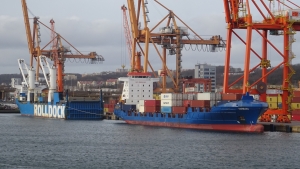Trucks on ships.Time for short sea shipping

 By Marek Grzybowski
By Marek Grzybowski
The Upply x Ti x IRU index of European road freight transport shows that in the third quarter of 2023, the spot rate index was still below the contract rate index – reports the International Road Transport Union (IRU) in the latest report. In 2023 and 2024, road transport will develop under the pressure of a lack of drivers and an increase in road tolls. This is an opportunity for sea, inland and rail transport.
The situation on the road transport market is improving and forwarders are still skeptical about the possibility of sending ro-ro cargo to sea or rail transport. freight transport in the EU amounted to 13.6 billion tonnes and transported 1,920 billion tonne-kilometers in 2022. The difficulty in transferring cargo to rail, sea and inland waterway transport mainly concerns perishable goods.
Road freight transport was dominated by food products, beverages and tobacco, transporting 317 billion tonne-kilometers. The largest road transport of goods within the country in tonnes was in Germany. Goods transported between Switzerland and Germany accounted for 17.6% of the total EU/non-EU tonnage transported, reports EU road transport statistics.
Less transport work on the roads
The analysis of freight rates shows that in 2023, some types of transport will see a decline in transport performance. On the EU market, including Poland, disruptions occurred due to the increased supply of transport capacity created by carriers from Ukraine.
For this reason, among others in the third quarter of 2023, the spot index fell even below the contract index. This currently means that spot rates are close to the base level from Q1 2017, states the IRU in a statement. This means that “The Cash Market Index fell for the fourth quarter in a row, down 1.2 points to 125.4, representing a year-over-year decline of 14.8 points.” Therefore, the rate of decline in spot rates has fallen by more than a third.” It is important to note that spot rates are starting to stabilize at low levels to adapt to lower level demand.
Therefore, it can be expected that the trend of 2022 will continue in 2023, when road freight transport in 2022 decreased in 12 EU countries compared to 2021. And it should be noted that the declines in transport occurred in most countries with ports and good access to sea connections.
Back then, the most significant declines were recorded in Estonia (-13.3%), Belgium (-7.4%) and Lithuania (-6.9%). In another 12 EU countries it recorded increases. The highest increases in road freight transport occurred in Cyprus (29.8%), Luxembourg (6.5%) and Slovakia (4.3%). Total transport in Bulgaria and Portugal remained stable for two years. For comparison, road freight transport in 2021 decreased in three EU countries compared to 2020. It was lowest in Greece (-16.3%), Slovakia (-4.6%) and Finland (-0.2 %). It saw an increase in all other EU countries, from 32.2% in Portugal to 0.9% in Germany.
Downward trend in cabotage transport
Cross-border and cabotage transport decreased, accounting for a total of 13.3% of the total supply of transport services in the EU in 2022. The decreases were 0.1% for cross-border transport and 8.9% for cabotage. In 2021, both cases saw increases compared to 2020 by 4.0% and 6.7%, respectively.
This situation caused the situation to stabilize at lower levels in 2023. Because as the International Road Transport Union states, “The comparative index of European freight transport contract rates in the third quarter of 2023 was 128.1, 1.4 points higher than in the second quarter of 2023, and currently it is only 0.4 points higher lower compared to the third quarter of 2022.”
But there is a threat. – The increase in toll prices in Germany in December could increase toll costs by up to 83%, which could be passed on to customers. Road toll rates are also expected to increase in other EU member states in 2024, warns the IRU, although road toll increases are not yet known.
Time for short sea shipping
New IRU forecasts say driver shortages across Europe are expected to worsen again, with 11% of vacancies remaining unfilled in 2024. – Freight rates are expected to remain low with a slight seasonal increase in the fourth quarter, but is expected It is expected that the rates will stabilize in 2024 as demand recovers in Europe and costs increase, announces IRU.
This information is important for Polish transport companies. Polish companies perform approximately 20% of transport work in the EU. Transporters from Germany take 2nd place with a share of 16%, and from Spain – 14% and France – 9%. Road toll increases and driver shortages will not be replaced by Ukrainian drivers, who will probably be “pulled” from the market to the front where there is a shortage of men.
The latter factors should direct the attention of forwarders and road transport operators to the transport of cargo or vehicles by sea, inland waterway and rail. Good port infrastructure should facilitate the transfer of cargo to rail transport and ships.
The increase in road tolls and the shortage of drivers will force operators to optimize truck transport. In times of economic slowdown, there is time to prepare for increased demand in times of economic growth. Port and railway terminals should already be thinking about preparing for the increased supply of trucks.
